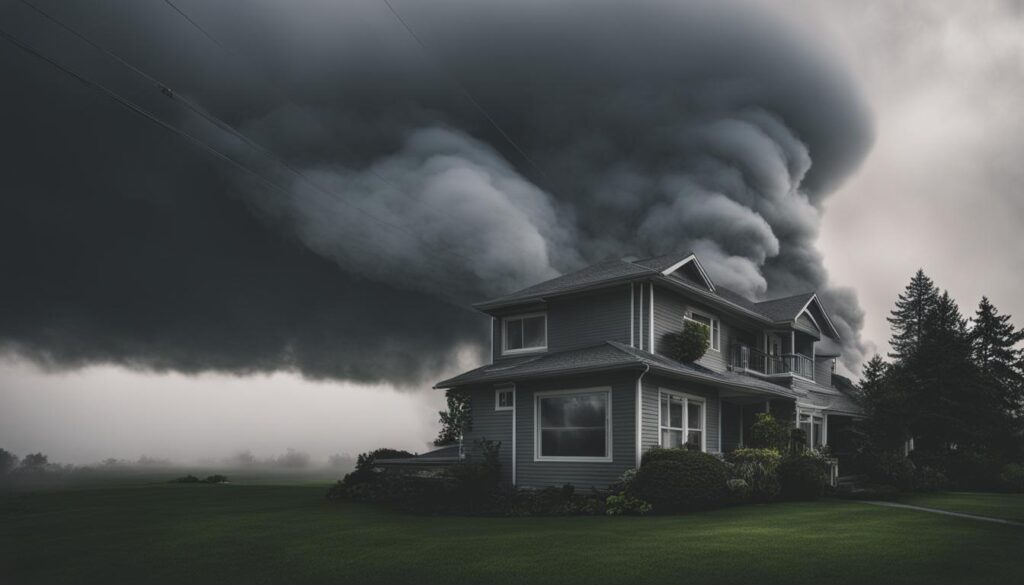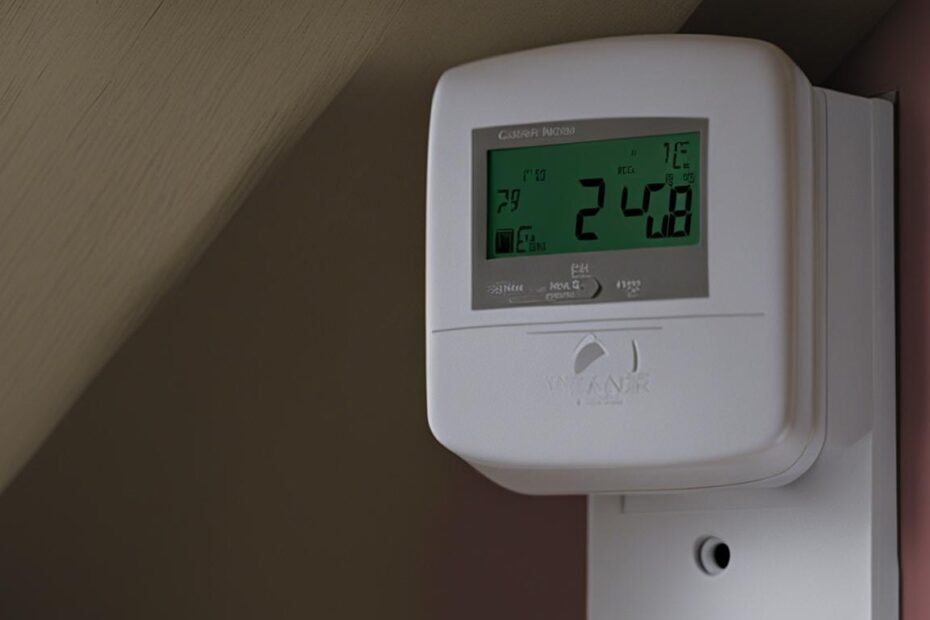Welcome to our guide on carbon monoxide (CO) detector safety tips! Carbon monoxide is a silent killer that cannot be detected by our senses, making it crucial to have the right safety measures in place. In this article, we will provide you with essential tips to protect your home and loved ones from the dangers of carbon monoxide.
Key Takeaways:
- Install a working carbon monoxide (CO) alarm on every level of your home, especially around sleeping areas.
- Test CO alarms every month and replace them according to the manufacturer’s instructions.
- Have both CO alarms and smoke detectors in your home. Make sure you know the sound of each alarm.
- To prevent CO leaks, remove vehicles from the garage immediately after starting them, use generators and grills outside the home, avoid using the oven or stovetop for heating, and regularly check and clear vents for the dryer, furnace, stove, and fireplace.
- In the event of a CO alarm, quickly leave your home and move to a safe location outside. Call 911 or the fire department and stay outside until emergency personnel declare it safe to re-enter.
What is Carbon Monoxide and Why is it Dangerous?
Carbon monoxide (CO) is an invisible, odorless gas that poses a serious threat to human health. It is produced during the incomplete combustion of fossil fuels such as natural gas, gasoline, coal, and wood. Common fuel-burning appliances found in homes, including furnaces, dryers, ranges, water heaters, and space heaters, can produce carbon monoxide if there is a malfunction or lack of proper ventilation.
What makes carbon monoxide so dangerous is its ability to bind with the red blood cells in our bodies, reducing their ability to carry oxygen. This can lead to a range of symptoms, from mild headaches and nausea to severe flu-like symptoms, unconsciousness, and even death. The insidious nature of carbon monoxide makes it difficult to detect without the help of carbon monoxide detectors.
Everyone is at risk of carbon monoxide poisoning. However, certain groups are particularly vulnerable, including unborn babies, infants, children, seniors, and individuals with pre-existing heart and lung problems. It is crucial for households to be equipped with carbon monoxide alarms to prevent the devastating effects of carbon monoxide poisoning.
Here are some important steps to protect yourself and your loved ones from carbon monoxide poisoning:
- Install CO alarms: Place carbon monoxide detectors on every level of your home, especially near sleeping areas and in the vicinity of fuel-burning appliances. Ensure that the alarms are in good working condition and replace the batteries regularly.
- Regularly maintain fuel-burning appliances: Have your furnaces, dryers, ranges, water heaters, and space heaters inspected and serviced by qualified professionals. Proper maintenance and regular checks can help identify any potential issues that may lead to a CO leak.
- Ensure proper ventilation: Make sure that all fuel-burning appliances are properly vented to allow the safe release of carbon monoxide. Regularly clean and clear vents, flues, and chimneys to prevent any blockages that could lead to a buildup of CO gas.
- Follow cooking safety guidelines while camping: When using portable stoves, grills, or lanterns, operate them outdoors and away from enclosed spaces to prevent carbon monoxide buildup. Never use these appliances inside tents, campers, or other enclosed areas.
By taking these precautions and staying vigilant, you can significantly reduce the risk of carbon monoxide poisoning in your home and ensure the safety of your family.

How Carbon Monoxide Detectors Work and Important Maintenance Tips
Carbon monoxide detectors are a crucial part of keeping your home safe from CO exposure. These devices are designed to detect the presence of carbon monoxide gas and sound an alarm to alert the occupants. By having a CO detector installed, you can have peace of mind knowing that you will be promptly warned if CO levels rise to dangerous levels.
CO is a simple molecule made up of carbon and oxygen. Carbon monoxide detectors work by sensing the levels of CO in the air and activating an alarm when a certain threshold is reached. There are different types of CO sensors, including biomimetic, metal oxide semiconductor, and electrochemical sensors. Each sensor type has its own way of detecting carbon monoxide and providing accurate results.
To ensure proper protection, it is important to install carbon monoxide detectors on every level of your home, near bedrooms, and even in the garage. Regular testing is necessary to make sure the alarms are functioning correctly. It is recommended to test your CO detectors monthly and replace their batteries as needed. Additionally, sensor maintenance should be performed according to the manufacturer’s instructions.
Carbon monoxide exposure can be dangerous, even at low levels. Symptoms can occur when CO levels reach as low as 70 parts per million (ppm). That’s why it’s crucial to take immediate action when a carbon monoxide alarm sounds. Evacuating the premises and opening doors and windows for ventilation are important steps to take. If symptoms are present, it’s advisable to seek medical attention as well.
FAQ
How many carbon monoxide detectors do I need in my home?
It is recommended to install a working carbon monoxide (CO) alarm on every level of your home, especially around sleeping areas.
How often should I test my carbon monoxide alarm?
Test CO alarms every month and replace them according to the manufacturer’s instructions.
Should I have both carbon monoxide alarms and smoke detectors in my home?
Yes, it is important to have both CO alarms and smoke detectors in your home. Make sure you know the sound of each alarm.
How can I prevent carbon monoxide leaks in my home?
To prevent CO leaks, remove vehicles from the garage immediately after starting them, use generators and grills outside the home, avoid using the oven or stovetop for heating, and regularly check and clear vents for the dryer, furnace, stove, and fireplace.
What should I do if my carbon monoxide alarm goes off?
In the event of a CO alarm, quickly leave your home and move to a safe location outside. Call 911 or the fire department and stay outside until emergency personnel declare it safe to re-enter.
What is carbon monoxide and why is it dangerous?
Carbon monoxide (CO) is an invisible, odorless gas produced during incomplete combustion of fossil fuels. It is dangerous because it binds with red blood cells and deprives the body of oxygen, leading to flu-like symptoms, unconsciousness, and even death.
Who is at risk of carbon monoxide poisoning?
Everyone is at risk of CO poisoning, but certain groups like unborn babies, infants, children, seniors, and individuals with heart and lung problems are more vulnerable.
How can I protect against carbon monoxide poisoning?
To protect against CO poisoning, install CO alarms, have appliances checked regularly, ensure proper ventilation, and follow cooking safety guidelines while camping.
How do carbon monoxide detectors work?
Carbon monoxide detectors are essential for preventing CO poisoning. They detect the presence of CO gas and sound an alarm to alert occupants. Detectors sense CO levels using different types of sensors such as biomimetic, metal oxide semiconductor, and electrochemical sensors.
Where should I install carbon monoxide detectors in my home?
CO detectors should be installed on every level of the home, near bedrooms, and in the garage. Regular testing, battery replacement, and sensor maintenance are crucial for proper functioning.
At what CO levels should I be concerned and what should I do?
CO exposure can cause symptoms at levels as low as 70 parts per million (ppm). When an alarm sounds, evacuate the premises, open doors and windows for ventilation, and seek medical attention if symptoms are present.
